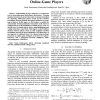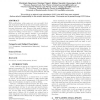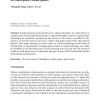100 search results - page 14 / 20 » A peer-to-peer architecture for massive multiplayer online g... |
IJVR
2007
13 years 7 months ago
2007
—Understanding of player behaviors is an important issue to keep online games interesting to their players. Focusing on player movement, in our previous work, we proposed a metho...
DSRT
2004
IEEE
13 years 11 months ago
2004
IEEE
State-of-the-art Massively Multiplayer Games such as EverQuest and Ultima Online are currently implemented as client-server systems. Although this approach allows the development ...
NETGAMES
2006
ACM
14 years 1 months ago
2006
ACM
In recent years, MMORPG has become popular. In order to improve scalability of game system, several P2P-based architectures have been proposed. However, in P2P-based gaming archit...
CCR
2007
13 years 7 months ago
2007
While multi-player online games are very successful, their fast deployment suffers from their server-based architecture. Indeed, servers both limit the scalability of the games a...
NETGAMES
2006
ACM
14 years 1 months ago
2006
ACM
Synchronization protocols based on “dead-reckoning” are vulnerable to a popular type of cheat called speed-hack. A speed-hack helps a cheater to gain unfair advantages by essen...



